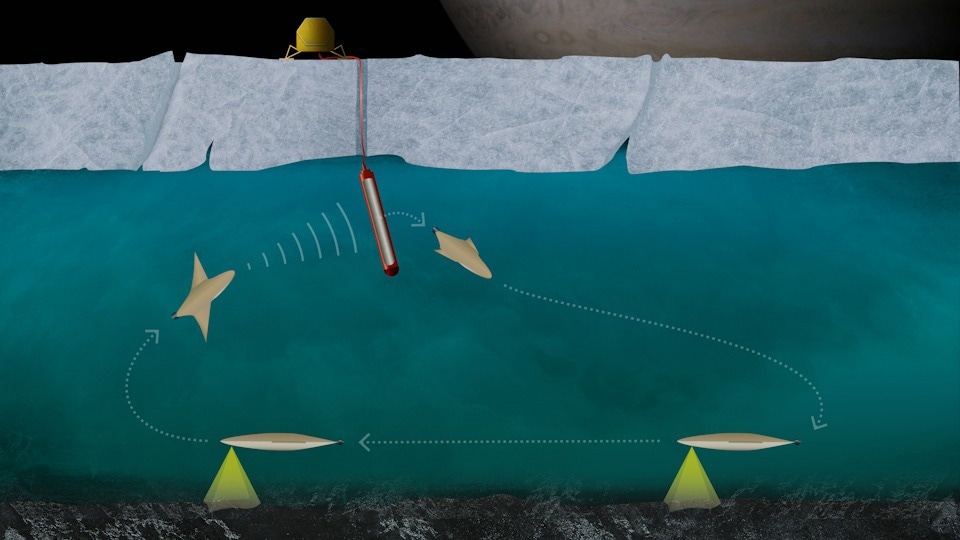
The illustration shows the operation of the station, the melting probe, and the nanoAUV. These will make it possible to explore ice-covered water bodies. The demonstration field test on the Ekstrom Ice Shelf in Antarctica near Neumayer III Station, which will conclude the second phase of development, is planned for 2026. Image Credit: MARUM–Center for Marine Environmental Sciences, University of Bremen
In outer space, the existence of water could mean the chance of life, even when it is situated beneath an ice layer.
The examination of such water bodies lying kilometers below an ice sheet on the Earth is a huge difficulty, and even more so in outer space.
How could high-technology tools pervade the thick ice crust, and how could the exploration of the underlying ocean be performed under the extreme environmental conditions that survive there?
What types of scientific sensors are essential in the search for signs of life there? How could samples be recovered? How can all this be achieved in the absence of contaminating an ecosystem as yet unidentified?
The collaborative project TRIPLE-nanoAUV 2, which has been coordinated at MARUM, mainly exists to fulfill these technological difficulties.
The acronym TRIPLE refers to “Technologies for Rapid Ice Penetration and Subglacial Lake Exploration.” Together with the TRIPLE collaborative projects TRIPLE-GNC and TRIPLE-LifeDetect, the project is part of the DLR Explorer initiatives.
Progress made in the TRIPLE projects will be integrated into Phase 2 and tested collaboratively during a field trial under the Antarctic ice shelf near the Neumayer III Station in the spring of 2026.
For this to happen, a small Autonomous Underwater Vehicle (AUV) as well as an LRS (Launch and Recovery System) will be built at MARUM in partnership with industrial partners from the aerospace and underwater-acoustic fields and also from the other concerned TRIPLE projects.
The LRS will allow the nanoAUV to dock with an underwater station to send the gathered data and charge its batteries, which will enable it to stay underwater longer. Since the vehicle has to be transported via the ice as payload within a melting probe, it will be much smaller compared to what is usual for underwater vehicles, with a diameter of around ten and a length of about 50 cm.
It is hoped that there are unidentified ecosystems in the subglacial lakes below the continental ice of Antarctica. Technologically, exploration of the water body, which has been covered by up to 4,000 m of ice, is extremely demanding.
Such nano-vehicles can help to provide a better overall understanding of marine ecosystems. The new autonomous system is unique and should make it possible in the future to study the global liquid-water ocean below the icy surfaces of Jupiter’s moon Europa and Saturn’s moon Enceladus.
Ralf Bachmayer, Professor and Project Leader of MARUM, Center for Marine Environmental Sciences, University of Bremen
Bachmayer added, “Miniaturization is the primary challenge in its development, with the probe dictating the overall size. In addition, all of the components must be able to withstand the high pressure under water.”
“The objective is to garner expertise within the DLR Explorer initiatives that could be used in a possible international space mission. The first field tests will deploy the melting probe with the nanoAUV integrated as payload in ice with a thickness of 100 meters. In addition, the nanoAUV is underactuated compared to larger autonomous vehicles, meaning it has limited maneuverability. This necessitates an extremely high reliability and close coordination among the associates from TRIPLE-GNC and TRIPLE-LifeDetect,” explained leading engineer Sebastian Meckel.
This project represents a continuation of previous collaborative efforts, such as TRIPLE-nanoAUV1 and TRIPLE-MoDo, building upon the developmental concepts for an autonomous vehicle and its docking station. In parallel, the TRIPLE-IceCraft project has focused on the development of a melting probe, which will penetrate the ice cover at Neumayer III and deploy the nanoAUV into the underlying water.
Additional associated projects are concurrently working on various aspects, including navigation software and the scientific payload for the autonomous vehicle. Furthermore, insights from the ROBEX project, in which MARUM played a significant role, are also being incorporated. This marks the pioneering integration of space and deep-sea research, with the development of robotic systems tailored for extreme environments.
MARUM and the University of Bremen are jointly overseeing the current project, with the support of corporate partners DSI Aerospace Technologie GmbH in Bremen and EvoLogics GmbH in Berlin. This project is funded with a total budget of 2.68 million Euros and is scheduled to run until September 2026.
The overarching coordination of the TRIPLE project series is being managed by the German Space Agency at DLR (Deutsches Zentrum für Luft- und Raumfahrt). Alongside TRIPLE-nanoAUV, the second phase includes parallel projects like TRIPLE-GNC (Guidance, Navigation, and Control), TRIPLE-LifeDetect (scientific payload), and TRIPLE-FRS 2 (Forefield Reconnaissance System, designed for implementation in the melting head of the ice-melting probe). The TRIPLE project line is a part of the DLR Explorer Initiatives.